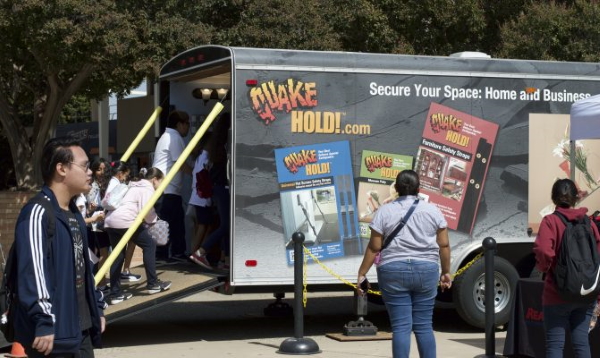[Having grown up in Los Angeles, I can relate to this short story from the Daily Titan about a mobile earthquake simulator used to increase public awareness and safety. For more information see coverage (including a 1:17 minute video) from Seattle’s KING5 TV, the Big Shaker website and the Great Shakeout Earthquake Drills website (October 17 is International ShakeOut Day). For two different approaches to earthquake simulators, see ReleifWeb for information on international “VR-based disaster resilience training simulations” and the University of California, San Diego for information on the world’s largest outdoor earthquake simulator. –Matthew]

Big Shaker event simulates Ridgecrest earthquake at CSUF
Diana Tran
October 13, 2019
The world’s largest mobile earthquake simulator shook Cal State Fullerton, north of Titan Shops, last week during the Big Shaker event.
The simulator recreated the 7.0 magnitude earthquake that shook Ridgecrest, California in July 2019.
“It is run by hydraulic systems and arms that were designed by a world-class hydraulic expert who did car shows. I built and designed the inside,” said Stuart Steingraber, the simulator’s technician.
The Great Shakeout has been around since 2008 and started as a Southern California event. Shakeout events are now held around the world, and the last mobile earthquake simulator that Steingraber built went to Japan.
The simulator models a home by including a couch, table and shelves decorated with items that could fall as shaking occurs. There was another simulator that has desks to help kids practice if an earthquake were to occur in school.
Priscilla Martinez, president of Geology Club, said she enjoyed the simulator, but felt it was scary at the same time.
“The things in there are plastic, but if they were glass or if they were concrete, it would probably cause a lot of damage,” Martinez said.
The club collaborated with the event by providing simulators to teach students more about earthquakes.
One simulator demonstrated the effects of liquefaction, which is when water-saturated sediment temporarily loses strength and acts as a fluid.
“The simulator is showing how buildings and cars will sink into the ground during an earthquake because water seeps from the bottom up, so as the water goes up, everything else goes down,” Martinez said.
The second simulator modeled the movement of the San Andreas Fault. It showed how tectonic plates move against one another and when the friction becomes too much, the plates snap to a different position.
Sue Fisher, the emergency management coordinator at CSUF, stressed the importance of being prepared for a worst-case scenario, such as the San Andreas Fault impacting people for several days.
If electricity, water or other functions are lost, she said people must have a plan and include everyone such as kids, elderly and pets.
“Getting down under a table or chair and trying to protect your head is the most critical thing. We try not to use the term ‘duck and cover’ because it has a specific connotation and doesn’t always mean the same thing in every language,” Fisher said.
The Emergency Preparedness Center advises people to remember “drop, cover and hold on!” For people in a wheelchair or with a walker, it is best to be seated and lock the wheels in place before covering and holding on so that the earthquake doesn’t move them around, Fisher said.
Ahsan Masood, CSUF student, tried the simulator for the second time.
“I tried the simulator once at a geology fair, and they immediately put you in an 8.3 (magnitude earthquake). It didn’t have any seat belts, so I was almost rolling on the ground,” Masood said.
Steingraber said his crew is currently building another mobile simulator that will be the largest one of its kind. He is aiming to have it ready by Oct. 17 and it will be located at Biola University.
It is uncertain when the San Andreas Fault will rupture because historic information does not provide enough data to establish whether or not there is a pattern in the timing of earthquakes, according to the U.S. Geological Survey.
“We have the San Andreas Fault 30 to 40 miles from here. It’s a major fault with a lot of potential energy, so when that earthquake fault actually does move, it’s going to highly impact us, so we really need to be prepared on what to do if that occurs,” Fisher said.
Leave a Reply